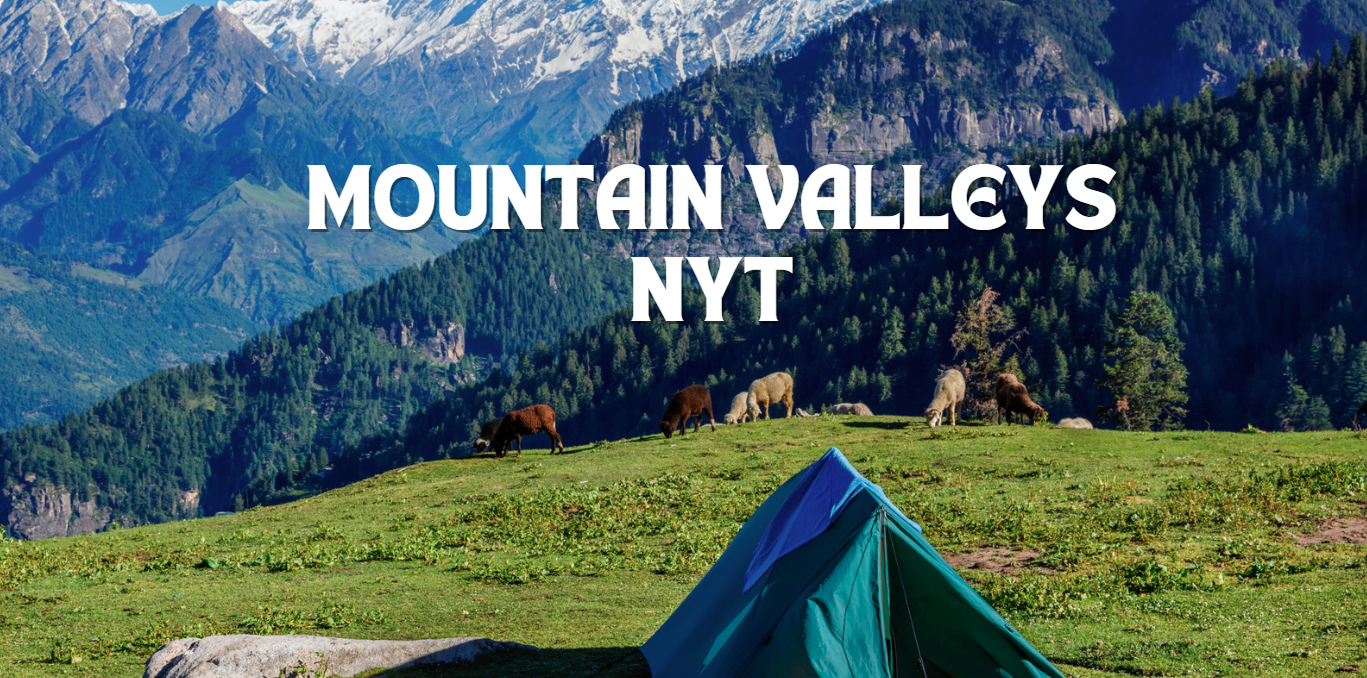Mountain valleys are among the most captivating natural landscapes on Earth. Their serene beauty, rich biodiversity, and cultural significance make them a topic of endless fascination. When discussing “mountain valleys nyt” (New York Times), we delve into a subject that has been explored through various lenses, from ecological importance to tourism and conservation.
This comprehensive article aims to surpass existing sources by offering in-depth interpretations, analyses, and insights that go beyond what’s currently available, making it a valuable resource for anyone interested in the splendor and significance of mountain valleys.
Contents
- 1 1. Introduction to Mountain Valleys
- 2 2. Geological Formation of Mountain Valleys
- 3 3. Biodiversity and Ecosystems
- 4 4. Cultural and Historical Significance
- 5 5. Mountain Valleys in the United States
- 6 6. Tourism and Recreation
- 7 7. Conservation Challenges and Efforts
- 8 8. The Impact of Climate Change
- 9 9. Personal Experiences and Anecdotes
- 10 10. Conclusion
- 11 11. FAQs
- 11.1 What are the main types of mountain valleys?
- 11.2 Why are mountain valleys important for biodiversity?
- 11.3 How does climate change affect mountain valleys?
- 11.4 What are some popular recreational activities in mountain valleys?
- 11.5 How can we promote sustainable tourism in mountain valleys?
- 11.6 What are some notable mountain valleys in the United States?
1. Introduction to Mountain Valleys
Mountain valleys are depressions or low areas between mountains, typically formed by geological processes over millions of years. These valleys are characterized by their unique topography, which includes steep slopes, flowing rivers, and lush vegetation. The beauty and tranquility of mountain valleys have inspired poets, artists, and travelers for centuries.
What Makes Mountain Valleys Unique?
Mountain valleys are unique due to their combination of geological, ecological, and cultural elements. They often serve as natural corridors for wildlife, offer rich soils for agriculture, and provide stunning landscapes that attract tourists and nature enthusiasts. The interplay of these factors creates environments that are both diverse and dynamic.
The Role of “Mountain Valleys NYT”
The term “mountain valleys nyt” refers to articles and features published by The New York Times that explore various aspects of mountain valleys. These pieces often highlight the beauty, challenges, and significance of these regions, providing readers with a deeper understanding and appreciation of mountain valleys.
2. Geological Formation of Mountain Valleys
The Science Behind Mountain Valleys
Mountain valleys are formed through several geological processes, including tectonic activity, glaciation, and erosion. Each process contributes to the distinct characteristics of different types of mountain valleys.
Tectonic Activity
Tectonic activity involves the movement of Earth’s lithospheric plates. When these plates collide or pull apart, they create mountains and valleys. This process can lead to the formation of rift valleys, which are characterized by steep, rugged terrain.
Glaciation
Glaciation is the process by which glaciers shape the landscape. During periods of glaciation, large ice sheets advance and retreat, carving out deep valleys and leaving behind U-shaped valleys, known for their broad, flat floors and steep sides.
Erosion
Erosion is the gradual wearing away of Earth’s surface by wind, water, and ice. Over time, rivers and streams erode the land, creating V-shaped valleys with narrow floors and steep walls. This process is ongoing and continues to shape mountain valleys today.
3. Biodiversity and Ecosystems
The Richness of Mountain Valley Ecosystems
Mountain valleys are biodiversity hotspots, home to a wide range of plant and animal species. The variation in altitude, climate, and topography within these valleys creates diverse habitats that support unique ecosystems.
Flora and Fauna
Mountain valleys host a variety of flora, from alpine meadows to dense forests. These areas are rich in plant species, many of which are endemic and adapted to specific microclimates. The fauna of mountain valleys includes mammals, birds, insects, and amphibians, each contributing to the ecological balance.
Ecosystem Services
Mountain valleys provide essential ecosystem services, such as water filtration, carbon sequestration, and soil stabilization. These services are crucial for maintaining environmental health and supporting human communities.
4. Cultural and Historical Significance
The Cultural Heritage of Mountain Valleys
Mountain valleys have been home to human societies for millennia. They offer fertile land for agriculture, abundant resources, and natural protection. Many cultures have developed unique traditions and lifestyles adapted to the mountainous environment.
Historical Events and Stories
Throughout history, mountain valleys have been the setting for significant events and stories. From ancient trade routes to battlegrounds, these valleys hold a wealth of historical knowledge. Understanding this history helps us appreciate the cultural depth of these landscapes.
5. Mountain Valleys in the United States
Iconic Mountain Valleys
The United States is home to several iconic mountain valleys, each with its own unique features and attractions. Some of the most notable include:
- Yosemite Valley, California: Renowned for its stunning granite cliffs, waterfalls, and diverse ecosystems, Yosemite Valley is a prime example of a glacially carved valley.
- Shenandoah Valley, Virginia: Known for its scenic beauty and historical significance, the Shenandoah Valley offers lush landscapes and a rich cultural heritage.
- Jackson Hole, Wyoming: Nestled between the Teton and Gros Ventre ranges, Jackson Hole is famous for its breathtaking scenery and outdoor recreation opportunities.
Exploring Mountain Valleys
Exploring mountain valleys in the United States offers a chance to experience nature’s grandeur and learn about the history and culture of these regions. Activities such as hiking, camping, and wildlife watching are popular ways to immerse oneself in the beauty of these valleys.
6. Tourism and Recreation
The Appeal of Mountain Valleys
Mountain valleys are top destinations for tourists seeking natural beauty, adventure, and relaxation. The unique landscapes and outdoor activities make them attractive to a wide range of visitors.
Popular Recreational Activities
- Hiking and Trekking: Trails in mountain valleys offer stunning views and opportunities to experience the natural environment up close.
- Skiing and Snowboarding: Many mountain valleys become winter sports hubs, attracting enthusiasts from around the world.
- Fishing and Boating: Rivers and lakes in mountain valleys provide excellent spots for fishing and boating.
- Wildlife Watching: The rich biodiversity of mountain valleys makes them ideal for wildlife observation.
Sustainable Tourism
As tourism grows, it is crucial to promote sustainable practices to preserve the natural and cultural heritage of mountain valleys. This includes minimizing environmental impact, supporting local communities, and educating visitors about conservation.
7. Conservation Challenges and Efforts
Threats to Mountain Valleys
Mountain valleys face various threats, including deforestation, pollution, climate change, and urbanization. These challenges can lead to habitat loss, reduced biodiversity, and ecological imbalance.
Conservation Initiatives
Efforts to conserve mountain valleys involve government policies, non-governmental organizations, and community actions. Key initiatives include:
- Protected Areas: Establishing national parks and nature reserves to safeguard critical habitats.
- Sustainable Practices: Promoting sustainable agriculture, forestry, and tourism practices.
- Community Engagement: Involving local communities in conservation efforts to ensure their support and participation.
Success Stories
Several mountain valleys have seen successful conservation outcomes. For example, the restoration of the Elwha River Valley in Washington State, following the removal of dams, has led to the revival of ecosystems and the return of salmon populations.
8. The Impact of Climate Change
Climate Change and Mountain Valleys
Climate change poses a significant threat to mountain valleys, altering temperature and precipitation patterns, affecting ecosystems, and increasing the frequency of extreme weather events.
Effects on Biodiversity
Changes in climate can lead to shifts in species distributions, altered phenology, and increased vulnerability to pests and diseases. Some species may struggle to adapt, leading to declines in biodiversity.
Mitigation and Adaptation Strategies
Addressing the impacts of climate change on mountain valleys involves both mitigation and adaptation strategies. Mitigation efforts focus on reducing greenhouse gas emissions, while adaptation strategies aim to enhance the resilience of ecosystems and human communities.
9. Personal Experiences and Anecdotes
Stories from the Valley
Personal stories and experiences offer a unique perspective on the beauty and significance of mountain valleys. Whether it’s a memorable hike, an encounter with wildlife, or a moment of solitude in nature, these anecdotes enrich our understanding and appreciation of these landscapes.
The Human Connection
The connection between humans and mountain valleys is profound. These landscapes offer a sense of peace, inspiration, and connection to nature that is deeply meaningful. Sharing personal experiences helps to highlight the emotional and spiritual value of mountain valleys.
10. Conclusion
Mountain valleys are extraordinary landscapes that captivate our imagination and offer immense ecological, cultural, and recreational value. By exploring their geological formation, biodiversity, cultural significance, and the challenges they face, we gain a deeper appreciation for these natural wonders. Through sustainable practices and conservation efforts, we can ensure that mountain valleys continue to thrive for future generations to enjoy.
11. FAQs
What are the main types of mountain valleys?
Mountain valleys are typically classified into U-shaped and V-shaped valleys. U-shaped valleys are formed by glaciation, while V-shaped valleys are created by river erosion.
Why are mountain valleys important for biodiversity?
Mountain valleys provide diverse habitats due to variations in altitude, climate, and topography. This diversity supports a wide range of plant and animal species.
How does climate change affect mountain valleys?
Climate change affects mountain valleys by altering temperature and precipitation patterns, impacting ecosystems, and increasing the frequency of extreme weather events.
What are some popular recreational activities in mountain valleys?
Popular activities include hiking, skiing, fishing, boating, and wildlife watching.
How can we promote sustainable tourism in mountain valleys?
Sustainable tourism can be promoted by minimizing environmental impact, supporting local communities, and educating visitors about conservation practices.
What are some notable mountain valleys in the United States?
Notable mountain valleys include Yosemite Valley, Shenandoah Valley, and Jackson Hole.
By offering a comprehensive exploration of mountain valleys, this article aims to provide readers with a deeper understanding and appreciation of these magnificent landscapes. Through unique insights, detailed analyses, and personal stories, we hope to inspire a greater connection to and stewardship of the natural world.







